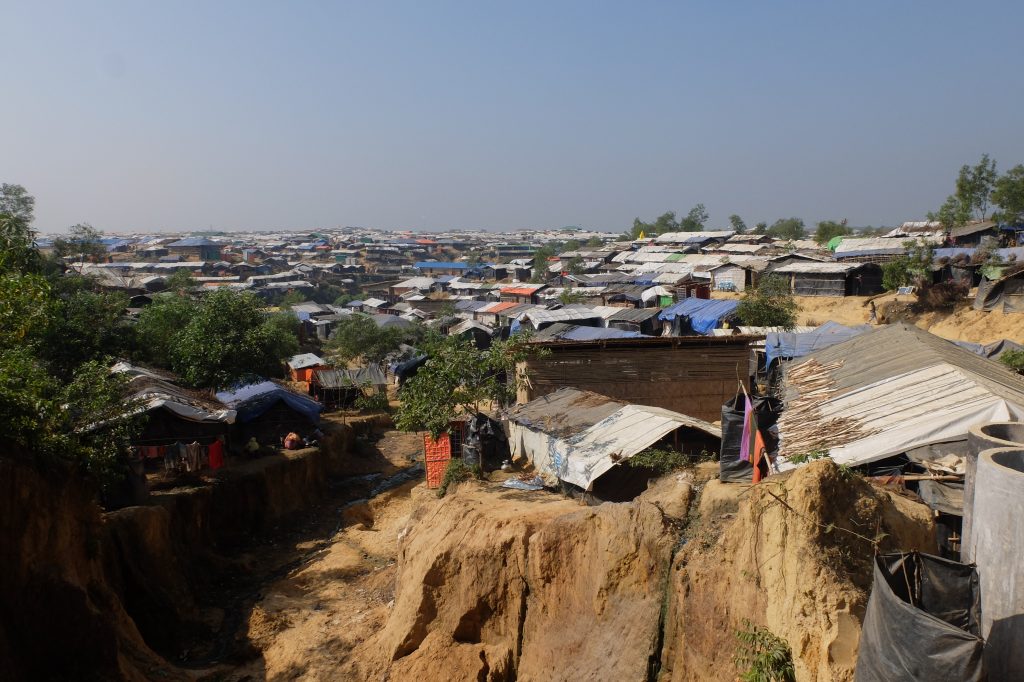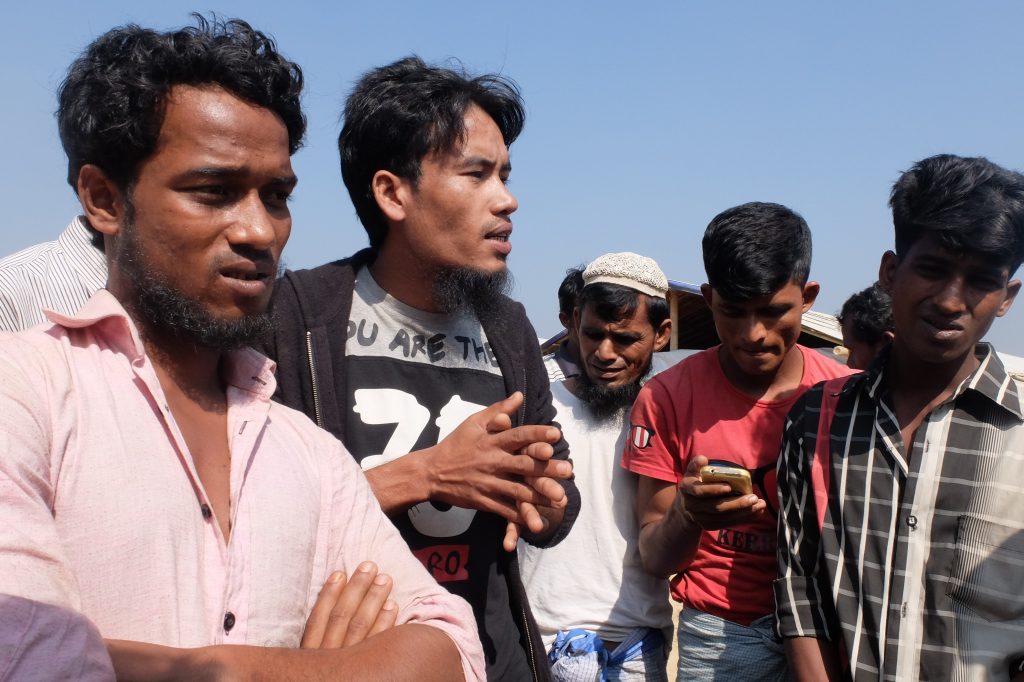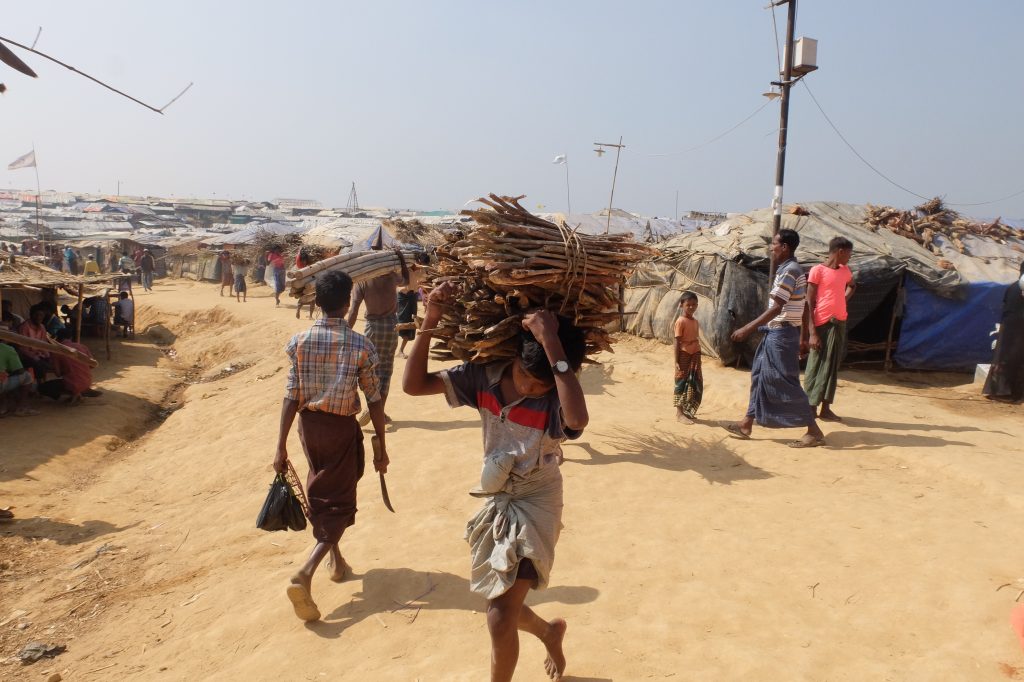Kutupalong refugee camp, Cox’s Bazar, Bangladesh
“We don’t want to stay here. But we can’t go back to Myanmar now. We don’t believe the government anymore.” Abdullah Islam – lips stained red from chewing betel leaves, black hair, bare feet – was a student in Myanmar. “I wanted to major in physics,” he tells me. Here, in the Kutupalong camp in Bangladesh, however, he is a refugee. Forced to flee his home – “it’s been three months now” – for being a Rohingya, a member of the Muslim minority in Myanmar’s Rakhine state, and persecuted by the military.
Together with neighbouring Balukhali, Kutupalong is the most populous Rohingya refugee camp. According to the latest report by the International Organization for Migration (IOM), currently 569,000 people live in the two camps. A full-blown city which continues to expand. Like many others, Abdullah Islam arrived here on foot, “after walking for seven days”, crossing the border a little further to the east. Meanwhile, local and international government and NGO operators arrive every day from Cox’s Bazar, Bangladesh’s main tourist destination. Bodegas along the water selling cheap souvenirs; fish joints; people taking sunset selfies on the beach; hotels for every budget lining the main road.

Work in progress inside the Kutupalong camp (image: Giuliano Battiston)
An hour’s drive from Cox’s Bazar – after leaving behind Himchari national park, the exclusive resorts, and the quiet farming and fishing villages – one turns right onto a dirt road in the town of Ukhia. This is the entrance to a different, unexpected world: the city of the Rohingya. A shapeless maze of streets intersecting and climbing up and down the cleared hills and occupied by thousands of tents built out of plastic sheets and bamboo, warm by day and cold by night, covering every inch of land as far as the eye can see. “Beyond that, there is only the ocean,” Sultan Mohammad Jainal Abedin from Action Aid Bangladesh explains before taking us on a tour of the camp.
The refugee camps in Bangladesh
Action Aid is one of the NGOs that were mobilised in the relief effort. Since August 25, 2017, IOM has recorded 655,000 arrivals of Rohingya. Most of them have ended up at Balukhali and Kutupalong, while 242,000 were sent to the other camps and 78,000 were taken in by local communities. In short, a demographic bomb going off in the southeastern corner of a poor, overcrowded country. An emergency that was met with a large-scale humanitarian response.
The biggest NGOs are all represented here, as are the UN agencies. IOM is coordinating the effort: “we were operating in the area before the August crisis,” Olivia Headon, information officer at IOM, explains. “We were the most qualified to coordinate the operations.” She quickly lists the problems: not much access to food nor to healthcare, education, drinking water, or psychological support. “And the extreme vulnerabilities of women, with instances of exploitation, human trafficking, abuse.”

The Kutupalong camp (image: Giuliano Battiston)
At the mobile clinic operated by Red Crescent Bangladesh with support from the Italian Red Cross, most of the patients are women and children. It is a simple wood and plastic building, light but solid: “So that we can easily move it where it is most needed,” Riccardo Bagattin, Red Cross field officer, explains. Doctor Erika Dellavalle and nurse Fabio Antonucci are treating a child who has a gastrointestinal infection. He will be able to go back to school in a few days. “There are some schools, but not enough of them,” 20-year-old Mohammad Sharur Hussein tells us. He teaches Burmese to a class of about seventy boys and girls. Sitting on their knees or on the floor along the perimeter of the classroom, they repeat a song while making gestures with their arms. “It’s not a proper schoolhouse, we don’t have desks or chairs, but it’s better than nothing,” Sharur Hussein comments, looking around. “The children need to adapt to their new surroundings.” But the present standstill is fuelling uncertainty and worries, compounding past trauma.
“Ours is an integrated project for health and social assistance,” mental health officer Cindy Scott tells us in the clinic operated by Médecins Sans Frontières. “We hear appalling stories of violence, rape, repeated abuse. This kind of trauma leaves a mark, and generates strong psychological reactions,” made worse by uncertainty about the future. Psychological support “is absolutely crucial,” Scott says, pointing out “the Rohingya’s extraordinary capacity for resilience.”
Dreaming of the future
Walking further into the streets of Kutupalong, speaking with women, men, and teenagers, we are struck by their desire to start over. Every family has known suffering, trauma, abuse, and nightmares. But the will to rebuild a life is stronger. “Let’s get this straight,” Abdullah Islam, the physics student, warns,“we are not here because we’re poor or because we don’t have any food. We are here because we’re being persecuted. Otherwise, we would know how to look after ourselves.” People are coming and going all around him outside the “Jubair Hotel”, a small food stand run by a Rohingya boy who makes pancakes. Some are carrying long bamboo boards, some have gathered firewood, some are collecting water from the well with buckets, digging earth to make stairs, building small huts with the bamboo the NGOs have given them or they have bought from the bazar, setting up bodegas, doing laundry. None of them are passively awaiting the future. They are trying to shape it, with no illusions. The Rohingya know very well that they are in limbo: “Going home? Only if we are given full citizenship rights. We want real protections,” Nur Mohammad, who is in his early twenties, says.

We are not going back to Myanmar: Nur Mohammad and other Rohingya teenagers discussing politics, demanding full citizenship rights (image: Giuliano Battiston)
No one here trusts the Myanmar government any longer: “We believed them in the past. We were wrong. It would be foolish to believe them now,” the teenagers keep saying, gathering around Nur Mohammad and Abdullah Islam. They all want to speak their minds. They are all demanding full citizenship rights. “We don’t want special rights, just the same ones as other citizens of Myanmar. Without those, we’re not going back. Better off here.” One of the young men is 29. He reminds us that the Rohingya have been forced to leave their homes before. “We fled and went back, then were forced to run again. Without negotiations supervised by the international community, there can be no talk of repatriation.” But even he does not fully believe in negotiations. “I have been living in Bangladesh for 25 years. 10 years here in Kutupalong. I know it’s hard.” A veteran of the diaspora. Next to him, a newcomer. “I’ve been here for four weeks. It’s not that bad.” But families have been torn apart. Some, they say, are still trapped in the no man’s land separating Myanmar from Bangladesh.
The no man’s land between Bangladesh and Myanmar
To get there we go back to the main road, then cross fields of blinding green lined by tall palms swinging in the wind. Dressed in red and green, a group of smiling girls comes out of the school. Across the street, the thick, dark green trees cover the hills that lead into Myanmar. The green strip ends abruptly before a stretch of barren hills. They look like panels of old, moth-eaten furniture. “These are the hills where the Rohingya first settled, before the camps were built,” we are told.
There are roadblocks. The military is controlling access. They don’t want any reporters. For obvious security reasons, the no man’s land is a sensitive area. But also because it contradicts government rhetoric. Prime Minister of Bangladesh Sheikh Hasina, who signed the repatriation agreement with the Myanmar government on November 16 of last year, keeps saying that the Rohingya “will soon return home.” The joint commission that will decide on the timing of the first returns has just been formed. “We will begin in January,” the leader of the Awami League insisted. The flow of refugees has stopped, an agreement is in place, we will soon be rid of the Rohingya: this is what all of Hasina’s statements, targeted at public opinion, really mean. The Bangladeshis have generously taken in hundreds of thousands of Rohingya, but they are increasingly worried about the long-term costs of welcoming refugees. “It will all be over soon,” Hasina reassures them. The no man’s land tells quite a different story.
Over the radio static, we get an unexpected message from the commander: we’re good to go. We reach the Naf River, which begins up in the Myanmar mountains of the former Arakan range and marks the border between the Teknaf Upazila in Bangladesh and Myanmar’s Rakhine state before flowing into the Bay of Bengal. The images of the Rohingya fleeing on makeshift boats have been taken on this river. A little to the south it swells, but here, in this season, its waters are placid. You can cross it easily on sacks of sand. On this side, on Bangladeshi soil, you can see farmers working in the fields. Across the water, but this side of the Myanmar border, there are hundreds of Rohingya families. They live in makeshift tents. From far up on the hills behind them, they are being watched by the Myanmar military. Their persecutors. Here they are being surveyed by Bangladeshi troops, bored but alert. The vigilance is constant and rigorous. Only medical emergencies are allowed through.
They keep coming
It is at places like this, monitored by the military, that the first selection takes place: the more vulnerable families, pregnant women, and small or sick children take precedence over everyone else. But they still need the go-ahead from the overflowing refugee camps. We are just a little bit away from the village of Gundum, in the northernmost part of the crossing zone, but places like this – some call them “bottlenecks” – are scattered all along the border, down to the last strip of Bangladesh territory to the south. And there are just as many Rohingya camps, some of them official, some of them informal, unevenly supported by government organisations and NGOs. As we have seen, Kutapalong and Balukhali are the most populous. Travelling south, however, one finds Thangkhali (43,500 people), Hakimpara (33,000), Bagghona and Potibonia (19,500), Chakmarkul (12,800), Jamtoli (48,800), Unchiprang (23,300), and, further down, past Teknaf, Leda (15,300) and Nayapara (23,000).

Daily life inside ghe Kutupalong camp (image: Giuliano Battiston)
Those are impressive numbers. And they are growing. Despite what Sheikh Hasina claims, the Rohingya are still fleeing Myanmar and entering Bangladesh. Even through this passage. Those with papers must walk all the way to the UNHCR Transit Center, along the main road. It’s a few hours’ walk, luggage in tow. We visit the centre. One of the officials there, Quadar, tells me that it has 120 tents and a capacity of about 1,000. “The tents are different sizes, one for each family. The families stay an average three or four days.” Just long enough to get their vaccinations, provided by MSF and Red Crescent, and to get some rest after the exhausting journey. Waiting for a place to become available in one of the camps. “Today we transferred 42 families,” Sara Motul points out, showing us the log. It records the names, ages, diseases – scabies, diarrhoea – of everyone who is transferred. The camp is divided into two main areas. The right side is for the more vulnerable: pregnant women or those with small children. They breastfeed the babies, while the toddlers play with twigs and leaves. The women all tell similar, tragic stories. Some of them have been left alone. “My husband was taken away. My eldest daughter was raped.”
We walk out of the Transit centre. A family of nine arrives. A couple, four children, a girl, and two elderly women. They set down their belongings: five plastic bags. The women and children stay and wait while the man walks towards the entrance. He pulls a sheet of paper out of a pocket in his shirt. He unfolds it carefully and shows it to the official. Their future is on those papers, on those stamps, on the controversial identification cards they will receive in the refugee camps. The papers are all in order. They will sleep here tonight. After that, who knows. We set off for the Cox’s Bazar of tourists, of beach selfies at sunset, and fish joints. Another world. Not very far, but very distracted.
Cover image: inside the Kutupalong camp; above, the Doctors Without Borders clinic (all images in this article by Giuliano Battiston)
Translation by Francesco Graziosi. Proofreading by Alex Booth.









